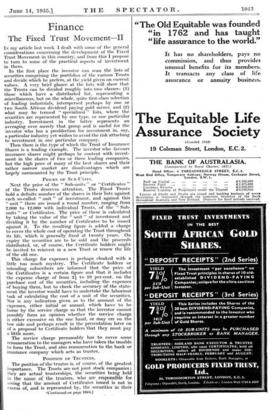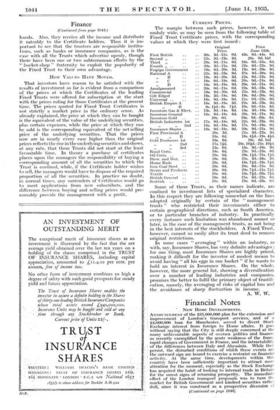Finance
The Fixed Trust Mo vement—II IN my article last week I dealt with some of the general considerations concerning the development of the Fixed Trust Movement in this country; and from this I propose to turn to some of the practical aspects of investment in. them.
In the first place the investor can scan the lists of securities comprising the portfolios of the various Trusts and decide which he prefers, at the yield given on current values. A very brief glance at the lists will show that the Trusts can be divided roughly into two classes: (1) thbse which have a distributed list, representing a miscellaneous, but on the whole, quite first-class selection of leading industrials, interspersed perhaps by one or two South African dividend paying gold mines, and (2) what may be termed " specialized " lists, where the securities are represented by one type, or one particular industry. Investment in the latter represents an averaging over merely that group and is useful for the investor who has a predilection for investment in, say, a particular industry yet wishes to avoid the risk attaching to investment in one particular company.
Then there is the type of which the Trust of Insurance Shares is a leading example. The investor who favours insurance shares might perhaps be content with invest- ment in the shares of two or three leading companies, but the high price of many of the best shares and their rather narrow market are disadvantages which are largely surmounted by the Trust principle.
PRICES OF SUB-UNITS.
Next the price of the " Sub-units " or " Certificates of the Trusts deserves attention. The Fixed Trusts hold a definite number of the shares in theirlists against each so-called " unit " of investment, and against this " unit " there are issued a round number, ranging from 2,000 to 12,000 with individual Trusts, of the " Sub- units " or Certificates. The price of these is calculated by taking the value of the " unit " of investment and dividing it by the number of Certificates to be issued against it. To the resulting figure is added a charge to cover the whole cost of operating the Trust throughout its life, which is generally fixed at twenty years. On expiry the securities are to be sold and the proceeds distributed, or, of course, the Certificate holders might be invited to reinvest in a new Trust or renew the life of the old one.
This charge for expenses is perhaps cloaked with a little too much mystery. The Certificate holders or intending subscribers are informed that the priee of the Certificates is a certain figure and that it includes the expense charge of from 24 to 10 per cent. on the purchase cost of the securities, including the expenses of buying them, but to check the accuracy of the state- ment the investor would have to undertake the laborious task of calculating the cost of a unit of the securities. Nor is any indication given as to the amount of the expenses, either initial ar annual, which have to be borne by the service charge so that the investor cannot possibly form an opinion whether the service charge is either excessive on the one hand, or may err on the low side and perhaps result in the presentation later on of a proposal to Certificate holders that they must pay a little more.
The service charge presumably has to cover some remuneration to the managers who have taken the trouble to form the Trust, and also remuneration to the bank or insurance company which acts as trustee,
POSITION OF TRUSTEES.
The position of the trustee is, of course, of the greatest importance. The Trusts are not joint stock companies ; they are actual trusteeships; the securities being held in the name of the trustees, who are responsible for seeing that the amount of :Certificates issued is not in excess of, and is represented by, the securities in their /Continued on page 1044.) Finance (Continued from page 1043.) • hands. Also, they receive all the income and distribute it rateably to the Certificate holders. Thus it is im- portant to see that the trustees are responsible institu- tions, such as banks or insurance companies, as is the case with all the Trusts which advertise openly, though there have been one .or two subterranean .efforts by the " bucket-shop " fraternity to exploit the popularity of the Fixed Trust to their own advantage.
How VALUES HAVE MOVED.
. That investors have reason to be satisfied with the results of investment so far is evident from a comparison of the prices at which the Certificates of the leading Fixed Trusts were offered for subscription at the start with the prices ruling for those Certificates at the present time. The prices quoted for Fixed Trust Certificates is not strictly a market price in the ordinary sense. As already explained, the price at which they can be bought is the equivalent of the value of the underlying securities, plus certain expenses, while the price at which they can be sold is the corresponding equivalent of the net selling price of the underlying securities. That the prices now are in nearly every case higher than the original prices reflects the rise in the underlying securities and shows, at any rate, that these Trusts did not start at the least favourable time. In theory a purchase of certificates places upon the managers the responsibility of buying a corresponding amount of all the securities to which the Trust is confined, while, if the CertifiCate holder wishes to sell, the managers would have to dispose of the required proportion of all the securities. In practice no doubt; in normal times, any surrenders of Certificates would go to meet applications from new subscribers, and the difference between buying and selling prices would pre- sumably provide the management with a profit.
CURRENT PRICES.
The margin between such prices, however, is not unduly wide, as may be seen from the following table of Fixed Trust Certificate prices, with the corresponding values at which they were first issued :
Original Price Price. June 12th. 30s. 3d.-31s. Od. 43s. 6d.-44s. Oct.
22s. 3d.-23s. 3d. 28s. Od. bid 20s. 9d.-21s. 6d. 24s. 6d.-25s., 6d. 20s. 3d.-21s. Oct. 22s. Od.-22s. 9d, 19s. 6d.-20s. 3d. 19s. 9d.-20s. 9d. 22s. 9d.-23s. 9d. 37s. 9d.-38s. 9d. 19s. 3d.-20s. 3d. 22s. 9d.-23s. 9d. 18s. Od.-19s. Od. 20s. Od.-21s. Od. 18s. 9d.-19s. Oct. 20s. Od.-21s. Od. 20s. Od.-21s. Od. 22s. 9d.-23s. 9d. 19s. 6d.-20s. 6d. 22s. 6d.-238. 6d. 18s. 3d.-18s. 9d. 19s. 6d.-20s. Od. 18s. 9d.-19s. 9d. 21s. Od.-22s. Od. 18s. 3d.-19s. 3d. 22s. 3d.-23s. 3d. 9s. 10.-9s. 74d. 10s. 9d.-11s. 3d. 13s. 9d.-14s. 6d. 15s. 3d.-16s. Oct. 18s. 6d.-19s. 'Oct. 20s. 9d.-21s. 9d.
20s. Od. 19s. 9d.-20s. 9d. 17s. 9d.-18s. 9d. 22s. Od.-23s. Od. I5s. 9d.-16s. 9d. 17s. Od.-18s. Od. 18s. 9d.-19s. 90. 20s. 9d.-21s. 9d.
20s. 3d. 21s. 3d.-228. 3d.
19s. Od. 18s. 44d.-19s. 41(I.
19s. Oct. 28s. 6d. bid 17s. 74d. 20s. 100.-218. 100.
15s. Od. 15s. 3d.-16s. 3d.
18s. 6d. 23s. 9d.-25s. Od.
20s. Od. 20s. lid.-21s.
20s. Od. 25s. 3d.-26s. 3d.
20s. Od. 18s. 74d.-19s. 71d.
20s. Od. 20s. 9d.-21s. 9d.
20s. Od. 20s. 70.-21s. 70.
20s. Od. 198. 7id.-20s. 7fd.
19s. 9d. 21s. 6d.-22s. 6d.
19s. 9d. 19s. Od.-20s. 03.
Some of these Trusts, as their names indicate, are confined to investment lists of specialized character. In this respect they are following somewhat on the lines adopted originally by certain of the " management trusts " who restricted their investments either to certain geographical directions, such as South America, or to particular branches of industry. In practically every instance such limitation was abandoned sooner or later, in the case of the management trusts, as not being in the best interests of the stockholders. A Fixed Trust, however, cannot so easily alter its trust deed to remove original restrictions.
In some cases " averaging " within an industry, as with, say, Insurance Shares, has very definite advantages ; for one thing, most Insurance Shares are' highly priced, making it difficult for the investor of modest means to avoid having " all his eggs in one basket " if he wants to hold an interest in Insurance Shares. On the whole, however, the more general list, showing a diversification over a number of leading industries and companies, promises the better to fulfil the primary object of trustifi- cation, namely, the averaging of risks of capital loss and the avoidance of sharp fluctuation in income.
First British Second „ Third „ Fourth ' , Fokeign Government National A „ B C D Amalgamated .. Commercial Gilt Edged Universal .. British Empire A
9' 1,
B Investors Gas & Elect. Investors General Investors Gold .. British Industries 1st „ 2nd Insurance Shares .. First Provincial A B Gold Producers 1st
PP 2nd PP „ 3rd
Rand Certs. . • Oil Certs.
Brew. and Dist. .. Home Rails Iron Coal Steel .. Stores and Products Textile .
British General .. Scottish ..
A. W. W.



















































 Previous page
Previous page